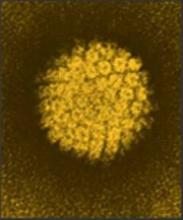BIRMINGHAM, ALA. – Minority adolescent girls are less likely than non-Hispanic white girls to receive a physician recommendation for human papillomavirus vaccination, according to a cross-sectional analysis of 2008-2012 national data from the National Immunization Survey-Teen.
Based on the survey of parents or guardians of 77,320 13-17-year old girls, the weighted proportion of non-Hispanic white girls who received a physician recommendation for HPV vaccination in 2008 was 54%, compared with 43%, 40%, and 47% for non-Hispanic black, Hispanic, and non-Hispanic other or multiple race girls, respectively.
The study was reported by Dr. Mahbubur Rahman and colleagues from The University of Texas Medical Branch at Galveston in a poster at the annual meeting of the American Society of Preventive Oncology.
A similar pattern was seen in the remaining years of the study. The weighted proportions for white vs. non-Hispanic black, Hispanic, and non-Hispanic other or multiple race girls were 60% vs. 50%, 51%, and 56% in 2009, 59% vs. 46%, 48%, and 56% in 2010, 63% vs. 52%, 51%, and 57% in 2011, and 70% vs. 63%, 56%, and 60% in 2012, the investigators said.
After adjustment for demographic characteristics, a separate weighted analysis for each year of data showed the differences between the non-Hispanic white girls and the other groups were statistically significant for all 5 years. The differences between the non-Hispanic black and Hispanic girls were not statistically significant.
The weighted adjusted odds ratio of receiving a physician recommendation for HPV vaccination among minority girls aged 13-17 varied from 0.81 to 0.87, between 2008 and 2012.
The findings confirm those from a 2009 study showing that white women were more likely than minority women to receive a recommendation for HPV vaccination in their adolescent daughters, and confirms that the findings is persistent, rather than a transient phenomenon.
This is notable, because according to 2013 data, HPV vaccine uptake among girls aged 13 to 17 years is lower than the Healthy People 2020 target of 80% for the 3-dose series among those aged 13 to 15 years. It is also below the level needed for herd immunity (75% to 94%), the investigators said, noting that studies show a strong association between provider recommendation and vaccine uptake.
In fact, provider recommendation is the best predictor of vaccine uptake; adolescent girls who receive a provider recommendation are five times more likely to initiate the HPV vaccine series than are those without a recommendation, they said.
“Reasons for racial disparity in receiving a physician recommendation need to be identified and interventions developed to achieve the targeted HPV vaccine uptake among U.S. adolescent girls irrespective of race/ethnicity,” they concluded.
The authors reported having no disclosures.


